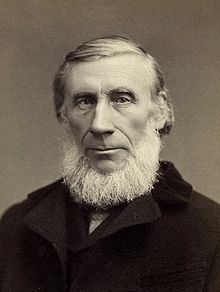Our website is made possible by displaying online advertisements to our visitors.
Please consider supporting us by disabling your ad blocker.
John Tyndall
This article has multiple issues. Please help improve it or discuss these issues on the talk page. (Learn how and when to remove these messages)
|
John Tyndall | |
|---|---|
 | |
| Born | 2 August 1820 Leighlinbridge, County Carlow, Ireland |
| Died | 4 December 1893 (aged 73) |
| Alma mater | University of Marburg |
| Known for |
|
| Spouse | |
| Awards |
|
| Scientific career | |
| Fields | Physics Chemistry |
| Institutions | Royal Institution (1853–1887) |
| Doctoral advisor | Friedrich Stegmann |
| Other academic advisors | Robert Bunsen Hermann Knoblauch |
| Notable students | Mihajlo Pupin[1][2] |
| Signature | |
 | |
John Tyndall (/ˈtɪndəl/; 2 August 1820 – 4 December 1893) was an Irish physicist and chemist. His scientific fame arose in the 1850s from his study of diamagnetism. Later he made discoveries in the realms of infrared radiation and the physical properties of air, proving the connection between atmospheric CO2 and what is now known as the greenhouse effect in 1859.
Tyndall also published more than a dozen science books which brought state-of-the-art 19th century experimental physics to a wide audience. From 1853 to 1887 he was professor of physics at the Royal Institution of Great Britain in London. He was elected as a member to the American Philosophical Society in 1868.[3]
- ^ "Музей истории телефона - История телефона".
- ^ Pupin, Michael. From immigrant to inventor. — New York, London: Charles Scribner's Sons, 1949. — p. 200. — 396 p.
- ^ "APS Member History". search.amphilsoc.org. Retrieved 26 April 2021.
Previous Page Next Page


